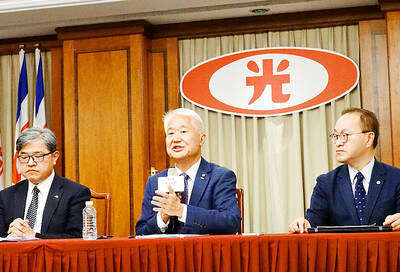More than a decade after fleeing Myanmar for Japan, Zarny Shibuya, 23, has become a rising fashion star whose face has graced Tokyo’s most-seen billboards, testing the country’s notorious reluctance to accept immigrants.
With cropped hair, pierced ears and a level but at times defiant gaze, the former model has become a fashion designer, turning out everything from sportswear to women’s clothing for several well-known brands and acting as style consultant for a popular TV series.
A finalist in a singing contest held by one of Japan’s largest record labels, he has appeared on the giant billboards in Tokyo’s hip Shibuya district, which feeds the latest fashion craze to thousands of young Japanese.

PHOTO: AFP
His second name — Burmese generally only have one — is a tribute to that area where the dizzying nightlife blurred his identity as he danced to 1980s pop.
It was there that he caught the eye of scouting agents, who propelled him to fame.
Nothing in his soft speech and gentle manner reveal he is a foreigner, let alone one blacklisted by the military junta in Myanmar as the son of prominent activists involved in the pro-democracy uprising crushed two decades ago.
“I immersed myself in Japanese culture. I cut off ties from the Myanmar community here. I came prepared with the thought that I may never return home,” Zarny said in fluent Japanese.
His is a rare success story in Japan, where many people proudly consider the country to be ethnically homogeneous.
Despite one of the world’s most rapidly aging populations, Japan has ruled out large-scale immigration and accepts only a small number of refugees.
When Zarny arrived in Japan with his mother at the age of eight, she told him to “swallow everything” and that meant racial slurs, too.
He was rejected when he applied for part-time jobs — including at several fast-food chains — because of his name.
“I finally had to use my Japanese friend’s identity. My interviewers would comment, ‘Your skin is so dark,’ but I would laugh it off and say, ‘No, no, I’m really Japanese,’” he said.
“I don’t think I could have become what I am now if my superiors had known from the start that I was a refugee and a foreigner,” he said, as he showed his latest creation, high-heeled, lace-up sneakers that make athletes seem better suited for the catwalk than the track.
Although many foreigners express frustration at being eternally treated as outsiders even if they speak fluent Japanese, Zarny insisted it was possible to enter Japanese society — at the cost of keeping his true identity under wraps, which is “the hardest feeling I’ve ever had.”
“Japan is not as restricted as Westerners think. In any society there are stereotypes and so it just depends on how well we turn them on their head,” he said.
And that is just what he did.
“I listened to popular rock music, wore clothes that were in style, I bought things like everyone else. I lived a life typical for my age. I didn’t think of myself as a poor, helpless victim,” the designer said.
He served as high-school class president and went on to graduate with a degree in international relations from a Japanese university.
All the while, the memories of his former home faded into nothing more than a still image of his grandfather’s study lined with books on Burmese mythology.
But for others in Japan who wished to hold on to their culture, “swallowing everything” was a bitter lesson in Japan’s reluctance to welcome foreigners despite being one of the world’s major democracies.
Easter Seng, 42, a leading activist from Myanmar’s Christian Kachin ethnic group, said it had been an uphill struggle trying to instill her tradition and language in her four daughters who were born in Japan.
“My daughters begged crying to have their names changed to Japanese after being bullied in school. They refused at first to learn Kachin, but I forced them to. Now they’re proud to be Kachin,” she said with a triumphant smile.
“I’m thankful to Japan for allowing me to live here but I can’t be satisfied. The government needs to take better care of foreigners because we can work for the good of Japan,” she said.
Japan is working, albeit slowly, toward opening up to foreigners as the work force dwindles in the face of a falling birthrate.
“If there are immigrants who love Japan and embrace Japanese culture, then I think they can become the new Japanese,” Hidenao Nakagawa, a senior lawmaker in the ruling party, said in a recent TV discussion.
For Zarny, learning the fine print — namely, Japanese etiquette, which foreigners often find overly fastidious — has been essential to his success.
“Refugees don’t have manners. I might sound harsh, but they really need to straighten themselves out if they want to be accepted. They need to show Japan that they are valuable human resources,” he said.
In turn, with globalization exposing young people to different cultures, more Japanese are stepping out of their insular mentality, he said.
“I think Japan changes greatly every decade in terms of culture and how people think. People my age are more open to the world, more cosmopolitan than people in their 30s,” he said.
“And when that happens and I’m an established designer, then I could begin to take inspiration from Burma,” he said.

People can preregister to receive their NT$10,000 (US$325) cash distributed from the central government on Nov. 5 after President William Lai (賴清德) yesterday signed the Special Budget for Strengthening Economic, Social and National Security Resilience, the Executive Yuan told a news conference last night. The special budget, passed by the Legislative Yuan on Friday last week with a cash handout budget of NT$236 billion, was officially submitted to the Executive Yuan and the Presidential Office yesterday afternoon. People can register through the official Web site at https://10000.gov.tw to have the funds deposited into their bank accounts, withdraw the funds at automated teller

PEACE AND STABILITY: Maintaining the cross-strait ‘status quo’ has long been the government’s position, the Ministry of Foreign Affairs said Taiwan is committed to maintaining the cross-strait “status quo” and seeks no escalation of tensions, the Ministry of Foreign Affairs (MOFA) said yesterday, rebutting a Time magazine opinion piece that described President William Lai (賴清德) as a “reckless leader.” The article, titled “The US Must Beware of Taiwan’s Reckless Leader,” was written by Lyle Goldstein, director of the Asia Program at the Washington-based Defense Priorities think tank. Goldstein wrote that Taiwan is “the world’s most dangerous flashpoint” amid ongoing conflicts in the Middle East and Russia’s invasion of Ukraine. He said that the situation in the Taiwan Strait has become less stable

CONCESSION: A Shin Kong official said that the firm was ‘willing to contribute’ to the nation, as the move would enable Nvidia Crop to build its headquarters in Taiwan Shin Kong Life Insurance Co (新光人壽) yesterday said it would relinquish land-use rights, or known as surface rights, for two plots in Taipei’s Beitou District (北投), paving the way for Nvidia Corp to expand its office footprint in Taiwan. The insurer said it made the decision “in the interest of the nation’s greater good” and would not seek compensation from taxpayers for potential future losses, calling the move a gesture to resolve a months-long impasse among the insurer, the Taipei City Government and the US chip giant. “The decision was made on the condition that the Taipei City Government reimburses the related

FRESH LOOK: A committee would gather expert and public input on the themes and visual motifs that would appear on the notes, the central bank governor said The central bank has launched a comprehensive redesign of New Taiwan dollar banknotes to enhance anti-counterfeiting measures, improve accessibility and align the bills with global sustainability standards, Governor Yang Chin-long (楊金龍) told a meeting of the legislature’s Finance Committee yesterday. The overhaul would affect all five denominations — NT$100, NT$200, NT$500, NT$1,000 and NT$2,000 notes — but not coins, Yang said. It would be the first major update to the banknotes in 24 years, as the current series, introduced in 2001, has remained in circulation amid rapid advances in printing technology and security standards. “Updating the notes is essential to safeguard the integrity